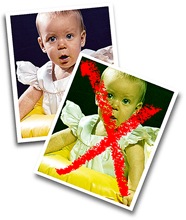When Good Color Goes Bad
By Mike Davis, Colorprep
Your photographer dropped off the digital camera shots you selected. No scanning needed -- they're RGB tiffs. His accompanying guide prints look pretty sweet. He mentioned that the "raw files" were also on the disk if needed and that they're like "digital negatives".
All you have to do is place the tiffs in your layout and send it all off to XYZ Printers, with a reminder on the RGB status. They're the experts when it comes to doing color separations, and of course, you want your color to be the best it can be. Your new client expects it as well. The prepress department down at XYZ Printers has been doing color for a long time, so they really know their stuff, right?
 (a few days later)
(a few days later)
"Ah, good, the proofs are back from XYZ Printers! Let's see here"
(silence, then long sigh) The color is, well, not as expected. You dial up the prepress manager at XYZ Printers:
"Say, Joe, was there a problem with the digital camera shots I gave you on the disk?"
"Not really. Nothing our folks couldn't handle. It did take them a while, though. I heard the color was way off, but we were able to go back and correct it all after seeing the first proofs come out. I'll tell you, we're seeing more and more of these whacky digital camera files."
Good color gone bad
This type of scene happens all too frequently. Who pays for the problems? Were the images shot badly? Says who? There's no transparency to match color! Digital photography is gaining ground at a great speed in the printing world as the benefits are realized. The truth is that many printing companies have been slow to make the changes necessary to accommodate the new images. The typical printing firm is not set up to process these files, and often stumbles through their conversions to CMYK often doing irreparable damage to the images that held such great promise when they arrived there.
But that was before:
- being improperly opened in Photoshop, with ICC profile tags discarded or changed due to incorrect preference settings.
- file edits were made visually on an uncalibrated display.
- separating the three RGB channels into four CMYK channels, using dubious settings and compounding the problems.
Then, in CMYK, the prepress comfort zone, the operator often attempts to fix the obvious problems with a series of layers, selections, masks and adjustments, while introducing new problems like banding, posterization, harsh tonal transitions and colors that look muddy, desaturated, neutralized and unappealing. Optimal maximum ink densities may shift up or they may go down. Then the operator fails to properly sharpen the whole mess (as this was always handled on-the-fly by the drum scanner since the pre-desktop era).
Everybody hates digital camera images now.
The sad part is it doesn't have to be this way. If you feel that you may not be seeing the full potential of your digital camera images, here are a few tips:
Work with digital photographers who can supply you with one of these, in order of preference:
1. FPO images for you to place in your layout plus the original raw files. These contain the virgin pixel captures straight from high-end digital cameras, prior to any conversion to RGB or any subsequent processing/encoding. You will need someone skilled to handle them, though.
2. Properly tagged RGB tiff images -- again, a skilled operator will be needed for best results.
3. CMYK tiffs prepared by a knowledgeable photographer. When feasible, separations should be prepared from the raw camera files, using the commercial printer's own printing profile settings if available, or at very least using Photoshop's "U.S. Prepress Defaults" with appropriate print environment settings (i.e. coated, uncoated, Web, sheetfed, newsprint, ink density, etc.).
Ideally, images should be scaled to your layout and sharpened for the specific print conditions (you may even want to request the full size CMYK or RGB tiffs without the final press sharpening or any significant press gain compensation for possible later use at other sizes). It can be difficult finding photographers able to handle this, but they are around.
Get help
Deal with printing companies whose prepress personnel understand the basics of color management, the importance of modern hardware-calibrated displays, and proper working/viewing environments. People who know the advantages of digital raw camera files and can explain why when asked. They know what color temperature is, they know what white balance means. They're comfortable working largely in RGB color but well acquainted with LAB and CMYK and can exploit each color space to your best advantage.
From your supplied page layout, savvy operators can see how an image is being cropped and will bring out the best in that visible portion of the shot. Areas cropped away and unseen can be harmlessly sacrificed to enhance the cropped portion.
These skilled folks will know whether your images were in fact shot badly, but you probably won't after they correct them.
Mike Davis
Mike Davis of Colorprep specializes in making digital camera color separations look their best, serving printers, graphic designers and photographers. Based in the Baltimore area, he can be reached at (410) 549-5564 or www.ColorPrep.us
Return to the Design Department, or back to the Front Page
Participate in your Design Center
Lots of fun and information for all... don't forget, any community is only as good as the participation of its members. We invite your tips, tricks, comments, suggestions and camaraderie.- Ask for the DT&G Monthly: to receive news about DT& headlines, happenings in the Design Center and regular columns like the "Mail Bag" and "Cool Sites"
- SUBSCRIBE : to the Designers' CAFE email list
